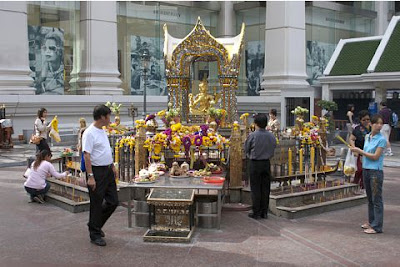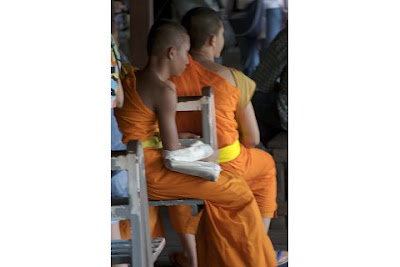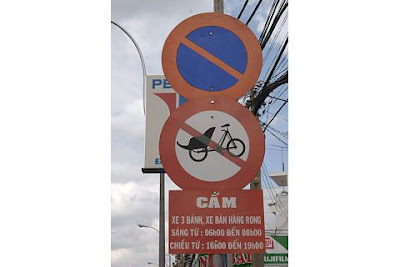Border crossing from Arranyaprathet, Thailand, into Poipet, Cambodia, is more stressful than the other way around. The casinos are right on the border, with sellers and market stalls outside. $40 rooms are had here if the onwards journey is postponed and a night’s stay is necessary. Otherwise, the main street just straight out from the border is lined with guesthouses of various price ranges. My $3 room was clean with a solid lock on a rickety door. The bus station was off this main road to the left, if walking away from the border, for my early morning bus ride.
If you purchased a trip from Bangkok to Siem Reap (Angkor Wat) or Bangkok-Phnom Penh, there is the possibility of a scam in Poipet. This can go along the lines of the bus breaking down, so if you want to get to Siem Reap or PP by nightfall, you have to pay extra to get on a bus that was leaving “right now” and happens to have extra seats. That’s an extra several dollars to $15.
If you took the train from Bangkok it will be around 2-3pm by the time you cross the border and need onwards transport. Touts of all sorts will approach you with options. Be mindful of the following ticket prices to adjust your bargaining (Phnom Penh-Siem Reap is roughly the same distance as Poipet-Phnom Penh, and also Poipet-Siem Reap as this latter trip’s road is in BAD shape):
A one-way ticket on a comfortable, clean, air-conditioned bus with a bathroom from Phnom Penh-Siem Reap costs around $12-$16. The cheapest ticket option where locals can ride roofside on a packed ‘taxi’ minibus for this same trip is around $3-6.
Just remember: If you haggle too hard, you’ll get shafted and may end up in another town altogether, late in the evening with no options (like we did, see below). Keep your cool, ask questions, pay fairly, and you’ll get safely to your destination.
My second trip through Poipet:
see my first border crossing into Poipet
First we stopped in Bangkok.
Although K has been to red light districts before, nothing quite prepared him—or me—for the Patpong mob scene in Bangkok. (Ah that mob scene was only the beginning…) That friendly smile…? It translates to “FRESHIE/SUCKER” hereabouts where people need just the slightest encouragement to keep harassing you for handouts or a sell. The gals came twelve-strong to our table in one of the fine evening establishments—with a ladyboy along just in case Keith’s taste ran the other direction—in a show of pressure that other foreigners walking in did not get. Tiny Asian gals crowded around K, who was trying to keep a shocked expression under control (unsuccessfully) at the whole situation and the vaginal acrobatics happening onstage. It was quite the amusing scene, until I saw one of them grab at his money and he let her take off with it.
–I did not! That was small change from the beers— which was about 20 dollars for two bottles, I might add. {{Edit to add upon K’s insistence that the girl only managed to get a 20baht note from him, which is about $0.50}}}.
So the next day I not-so-jokingly mentioned that if he EVER went out to Patpong for a bach party one day I will have to put a lock on him—
–A chastity belt-of-sorts? The boy asks, pleased at my apparent jealousy.
NO, a lock on your wallet, said I crossly.
Bangkok had all the comfort of any large bustling city. I was keen on the chocolate cakes here, which were moist and dense like a good cake should be (Cambodia did NOT get this memo). There is clean food (or minimal rotavirus–hey what’s the plural of virus? virii? viruses? anyone?), malls (there are no malls in Cambodia–not a huge loss, but the AC’d interior of a mall is nice once in a while, not to mention clothing designs that run around the vicinity of “normal”), and movie theaters (my movie critiqueing is getting dull by the day in Phnom Penh–we only have Khmer movies there). Oh and the pagodas and wats and the large Emerald Buddha that the Thais stole from Laos but tell tourists its theirs (the Laotians are quite bitter about this).
Bangkok was nice. But soon I sadly conceded that we must move on from the comforts of the big city. Onward ho, to a Kampuchean adventure.
K canNOT miss out on the experience of Poipet, so we did the do-it-yourself-border-crossing en route to Siem Reap and Angkor Wat in neighboring Cambodia. We hooked up with two female backpackers from the UK and New Zealand for the trip from Poipet to Siem Reap (and Angkor Wat)—for safety, I erred in assuming–and the combination of so much white skin put more than a bit of attention on us. The English hereabouts Cambodia is fine up until the actual exchange of cash, after which suddenly linguistic faculties fail and our deal with the locals to take us to Siem Reap went down the drain. There was no improvement in the road between Poipet and Siem Reap from when I came through a few months ago, so we bounced around the back of the flatbed of the pickup truck transportation we found, hanging on to our backpacks for dear life, which were sitting atop heaps of smelly days-old river catches. Those gaping patches of bridge?—our driver hummed right over them without hesitation. And what we thought was our transport to Siem Reap instead dumped us in Sisophon, three hours short of our destination, for a scam stop.
–As soon as our pickup truck rolled into Sisophon a feeding frenzy of the street sharks descended. Loud, broken English and Khmer were hurled about around us, and all we could make out was that they wanted us to get on another pickup and pay more. Now the thought of leaving the containers of fish I was forced sit on was appealing, but the deal we made was to ride this crowded (fish containers, old Khmer ladies, kids, and some dead unplucked chickens) pickup from Poipet to Siem Reap… not pay more money in Sisophon. The gals were quite aggressive back to our scammers, and they finally talked the guys down to a reasonable fee, but the journey doesn’t go smoother from here.
For some reason the men in the truck decided to abduct us. Having no familiarity with Sisophon, I looked at N, who through her work in the country knew the road we were taking was not the road to Siem Reap, but by then it was too late. They drove too fast for us to jump off, in circles to disorient us, and straight into a slum area, telling us we need to “come in and talk.”
Finally the vehicle slowed down and as the driver changed gears to reverse the truck into a gated house I jumped out of the back and grabbed everyone elses bags. N and the Brit followed suit. Luckily the Kiwi didn’t pass out from fright. Amid angry yelling back and forth from the men telling us we should come back and “be reasonable” we started trekking up the road away from the house, expecting at any moment to have a confrontation. They were demanding payment, for what I have no idea since they didn’t take us anywhere. We were all truly apprehensive about the whole event and I was mentally calculating which of the men needed to go down first should they decide we needed to be rounded up and marched back. I was afraid they might come after us with weapons; from my readings on the web that scenario certainly was not so farfetched in this country. Thankfully they let us be, perhaps they were too dumbfounded at our decisiveness, or they thought we would be too scared to walk out of this neighborhood and come crawling back for their help.
Luckily N had her phone, via which she beseeched upon her Khmer colleagues back in Phnom Penh to guide us back on track. We were in the middle of slum areas, with no idea where the bus station or the city proper was, and everyone on the sides of the road looked for all the world hostile and unfriendly. Four foreigners sporting large backpacks trekking about lost makes for quite a target, but we were not hassled. N called her translator and asked her to tell people around us to point us in the general direction of the bus station, and she sought random women posing relatively small threat to us to hand to phone to so that the translator can instruct the lady to point us to the direction we were seeking to go. She did this systematically several times for over an hour to make sure we were still traveling in the right direction, so that we finally managed to arrive, haggard, hungry, dirty, tired–but in one piece–at the bus station.
The moment we arrived we thought we made another mistake. It was filthy there, with garbage everywhere and stray animals poking their noses into everything, searching for food. Several broken-down stripped pieces of improvised transport littered the area. There were only men there, about a hundred of them, all gaunt, rags hanging off their starved frames, eyes gleaming like hyenas looking for meat. We stuck out like a beacon and they all immediately descended upon us in droves to offer their services, tripping over each other and trying to outscream everyone else in their desperation to make some money that day. Fist fights broke out around us as they beat on each other for our attention, and Nathalie, unknown to me until much later, was punched in the lip in the melee. I steered the other two girls over to where I saw a uniformed officer. When Nathalie saw our intent she hastened over and told us NEVER to seek police help if we were in trouble. We looked around and there is literally NO help available should these people decide to get some mob action started to take our shoes, clothes, bags, or money, and that is the most sinking feeling in the world. In not so few moments I found myself cursing the existence of this country and wondered for the millionth time what my wife was thinking when she plunked herself down on this hellhole.
The Khmer street sharks did not leave us be, crowding around and forcing their services on us–a moto taxi, a hotel room, food, etc etc– and we could not get a moment’s peace to even converse with each other to get a plan in gear. You just can’t think in that situation! Finally N broke away, snarled at the ones who followed her to get away, and got back on the phone. She asked her colleagues at the NGO in Phnom Penh to help us obtain a taxi out of Sisophon. Finally, after what seemed like days, via contacts of contacts from Phnom Penh to Battambang to Sisophon, her friends were able to help us get a legitimate taxi driver at the bus station and negotiate a fair fee for our onward transport. We were back on the road–the right road this time–to Siem Reap when the heavens opened up and poured down a storm.
Welcome to Cambodia! Why did we leave Bangkok???
And all this time with me yelling, “NO smiling! Hard look, hard look! You’re giving them reason to harass us!!!” Poipet is one of the most notorious border crossings, but nothing prepared us for that ordeal. I did not expect the chain of events we went through, and I just thank my lucky stars that I had some Khmer friends just a phone call away to help us.
Despite that nightmare, I am actually still quite taken with this country, which has a lot of potential and promise in its future. K understandably was not so keen on the whole scene, but after spending some time in Phnom Penh with me things slowly got better. It is still quite primitive for what he is used to. I think the way he handled the whole situation just made me fall more in love with him. Sappy I know, but how many people can find a gem of value in an experience like that, especially when it was unnecessarily forced upon him by someone who claims to love him?! What a trooper I married eh?
–Yeah, great experience of a vacation N, thanks– {{I didn’t hear sarcasm in that did I? he he}}}




































